Although summertime is well known as the best time to visit the stunning Yosemite National Park, and you’ll certainly be able to tell from the crowds, winter is also a fantastic time to go. Almost all of the activities you can do in summer are also available in winter in Yosemite, such as hiking, camping and visiting incredible lookout points.
Yosemite Valley covered in deep snowfall is possibly even more beautiful than when it’s blanketed in lush, green forest and activities that aren’t available in summer, such as skiing and snowshoeing, offer even more to do.
There’s lots to consider if you’re planning to visit Yosemite in winter, however, as a large section of the park is closed off and safety when hiking, camping and driving is a major factor when the roads are slippery. But if you’re keen to see dramatic sights and explore beautiful landscapes with fewer people, winter in Yosemite could be the perfect time.
Contents
- Yosemite in Winter
- Top Tours
- How To Get To Yosemite In Winter
- Getting Around Yosemite In Winter
- Top Tours
- What Is The Weather Like In Yosemite In Winter?
- Should You Stay Inside Yosemite National Park During Winter?
- Best Things To Do In Yosemite In Winter
- Top Tips For Visiting Yosemite In Winter
- When to visit
- Where To Stay In Yosemite In Winter
Yosemite in Winter
Top Tours
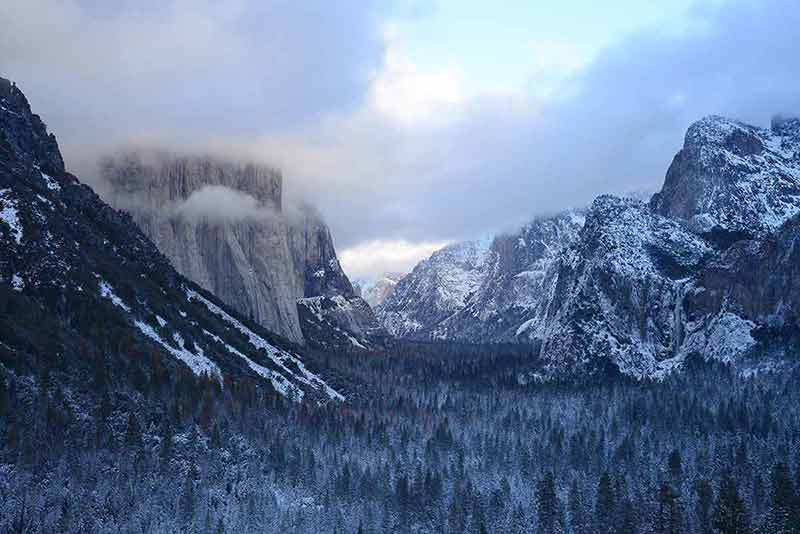
- 2-Day Yosemite National Park Winter Tour – a popular tour from San Francisco.
- Yosemite Valley Private Winter Hiking Tour – get out among nature with a guide.
- Full-Day Small Group Yosemite – includes Glacier Point with hotel pickup.
How To Get To Yosemite In Winter
Getting to Yosemite is fairly straightforward whether you go in summer or winter, however, summertime offers more access.
This is because, during the winter, much of Yosemite’s eastern area is closed due to heavy snowfall, including the major eastern road through the park, the Tioga Pass.
Therefore, during wintertime, you’ll need to enter via the west or south entrance.
You can reach Yosemite from Los Angeles in around 4.5 hours, via the southern entrance and from San Francisco in around 3 hours, entering via the western entrance at Big Oak Flat.
You may be wondering which entrances are open during winter, and you’d be right to as some are closed, such as the eastern entrance on the Tioga Pass.
There are three entrances that remain open year-round at Yosemite:
- South Entrance if you’re coming from Oakhurst
- Arch Rock entrance near El Portal in the west
- Big Oak Flat entrance coming from Groveland, also towards the west of the park
The northwest Hetchy Hetch entrance is also open year-round but is sometimes restricted to daylight hours, or may close unexpectedly if there is heavy snow.
Getting Around Yosemite In Winter
Top Tours

- Private Snowshoeing Adventure – from Badger Pass to Dewey Point.
- Private Giant Sequoia Grove Hike or Snowshoe – see the incredible giant trees.
- Private Hummer 4 X 4 Tour of Yosemite – including hotel pickup.
Most people arrive at Yosemite by car and in winter, you’ll find plenty of parking and you can use your car to get around to trailheads if needed.
During the warmer months, Yosemite has public transport options.
The YARTS (Yosemite Area Regional Transit System) that runs year-round is far less frequent in winter, just a few times per day.
Similarly, the free Yosemite Valley Shuttle continues to run during winter, but with fewer stops and less frequently.
This shouldn’t prevent you from reaching trailheads, or any of the main buildings in the Valley, but it’s worth regularly checking the timetable if there are any activities you consider unmissable.
When planning a trip to Yosemite during winter, whether you’re using your own car or a rental, make sure to use snow chains.
Additionally, check the NPS website for any road closures, storms, blizzards or other unsafe conditions that may affect your visit to the park.
Generally, roads within the park remain open during winter, mainly those leading into and out of the park and roads in Yosemite Valley, but the NPS website always lists up to date road closures.
The Tioga Pass closes between November and May without fail due to snow.
The beautiful Glacier Point Road is closed off in November, but is usually plowed in December to allow access to Badger Point Ski Area.
What Is The Weather Like In Yosemite In Winter?
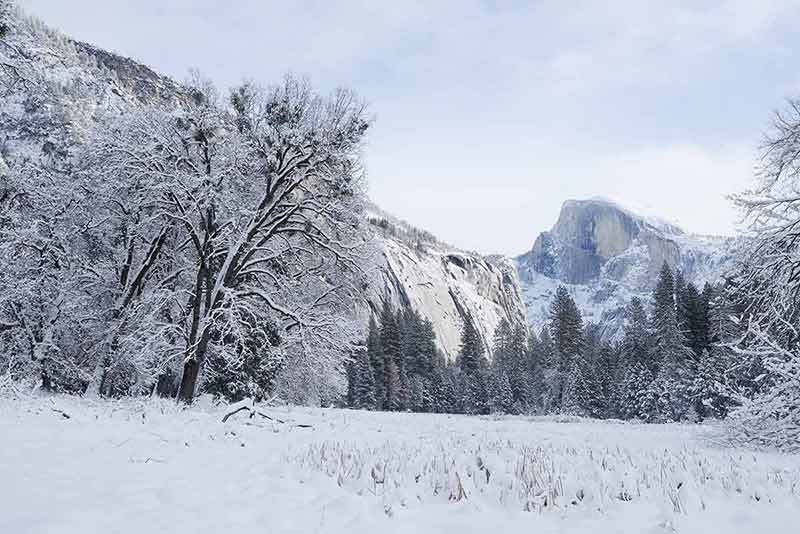
Stretching from November through to February and sometimes even into March, winter in Yosemite is generally very cold, with lots of snowfall.
Temperatures can drop to as low as -5, meaning snow boots and warm clothing are essential, as are plenty of snacks and water if you plan to hike, just in case trails take longer than expected.
Visiting during this time can be hit or miss for activities, as some days can be clear and sunny but very cold, while others may be heavy fog, rain or blizzards.
As winter eases off in February however, most days are bright and you can catch amazing sights such as the Firefall.
Should You Stay Inside Yosemite National Park During Winter?
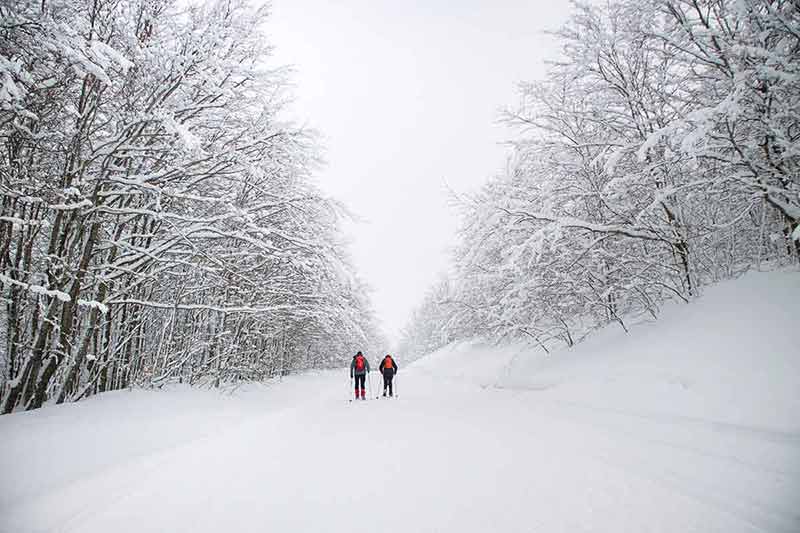
Recommended tour: 5-Day Yosemite Backpacking – Yosemite Icons
There are plenty of accommodation options in and around Yosemite National Park no matter which time of year you decide to visit.
You can stay outside the park in a nearby town such as Mariposa or inside the park such as at the famous Ahwahnee or even more rustic, at a campground.
However, during winter only one campground remains open and snow-free, at Upper Pines Campground.
In the busier months, reservations can be hard to come by at both hotels and campgrounds but the beauty of the cold weather is that you should find accommodation easily.
If you plan to stay more than a day and do multiple hikes, skiing or snowshoeing, staying in Yosemite Valley is a great idea, simply to save time driving in each day and evening.
You’ll find a great shop with supplies, a few good places to eat and more than one lodge to stay in.
For more California ideas, see:
- 40 Things To Do In Lake Tahoe
- 20 Things To Do In San Francisco At Night
- 21 Things To Do In Los Angeles At Night
- 23 Landmarks In Los Angeles
- 20 Landmarks In California
- 20 San Diego Landmarks
- 20 Songs About California
- Best Places To Visit in California
- 20 Things To Do In Santa Ana
- 20 Things To Do In Malibu
- Deserts In California Guide
- 20 Things To Do In Fremont
- 20 Things To Do In Berkeley
- 20 Things To Do In Monterey
- 20 Things To Do In Anaheim
- 20 Things To Do In Santa Rosa
- Best Time To Visit California
- Los Angeles To San Francisco Road Trip
- San Diego To San Francisco Road Trip
- 20 Things To Do In Ventura
- 20 Things To Do In San Luis Obispo
- 20 Things To Do In Palm Desert
- 20 Things To Do In Palm Springs
- 20 Things To Do In Pasadena
- Where To Stay In Los Angeles
- 20 Things To Do In Bishop CA
- San Francisco to Yosemite National Park Road Trip
- 20 Things To Do In Yosemite
- 20 Waterfalls In California
- 20 Things To Do In Big Bear
- 20 Things To Do In Laguna Beach
- 20 Things To Do In Solvang
- 20 Things To Do In San Ramon
- 20 Things To Do In Roseville
- 20 Things To Do In Carmel
- 15 Things San Francisco Is Famous For
- 20 Ghost Towns In California
- 20 Ways To Spend Christmas In California
- San Francisco Itinerary
- San Francisco Bike Tours
- San Francisco Go Cars
- Exploring Hearst Castle
- Yosemite National Park
- 9 California National Parks
- Lake Tahoe Snowshoe Adventure
- 20 Things To Do In Bakersfield
- 20 Things To Do In Redding California
- 20 Things To Do In Manhattan Beach
- 20 Things To Do In Fresno
- 20 Things To Do In Riverside
- 20 Things To Do In Long Beach
- 20 Places To Go Glamping In California
- 20 Things To Do In Eureka
- 20 Los Angeles Day Trips
- 20 San Francisco Day Trips
- 20 Things To Do In Santa Cruz
- 20 Things To Do In Beverly Hills
- 20 West Hollywood Bars
- 20 Things To Do In Half Moon Bay
- 20 Things To Do In Morro Bay
- 20 Beaches In San Francisco
- Grand Canyon National Park Photos
- 20 Things To Do In Stockton
- 20 Things To Do In Temecula
- 20 Things To Do In San Bernardino
- 20 California Cities
- 20 Things To Do In Irvine
- 20 Lake Tahoe Beaches
- 20 Things To Do In Yosemite in Winter
- 20 Things To Do In Lake Arrowhead
- 15 Things California Is Famous For
Best Things To Do In Yosemite In Winter
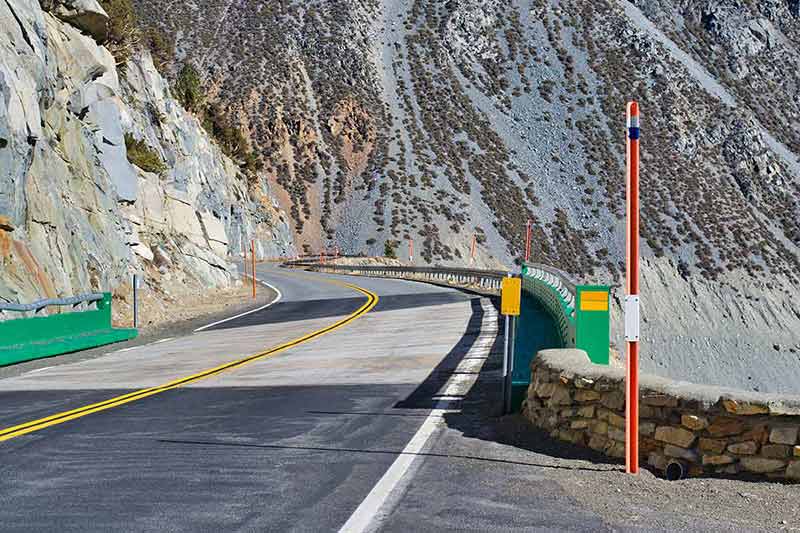
1- Admire The Tunnel View
Tunnel View is one of the first lookout points you can head to when driving into Yosemite from the west, and the best part is that it’s just off the side of the road, so you don’t need to hike anywhere.
If the weather suggests longer hikes or viewpoints might not be possible that day, heading to Tunnel View is a great way to tick off a spectacular view of Yosemite.
Tunnel View overlooks almost all of Yosemite National Park’s major sights, such as El Capitan, Half Dome, Bridalveil Falls and Cathedral Rocks and in winter, the valley and dense forest are dusted in snow as far as the eye can see.
Tunnel View is easy to reach too, located just past the Wawona Tunnel – there are plenty of signs as you enter the park and it should be the first thing on your list before even reaching Yosemite Valley.
2- Hiking
You’ll be happy to find out that despite the cold weather, pretty much all of Yosemite’s hiking routes remain open throughout winter.
Of course, more caution is needed and specialist equipment, plus cold weather gear and clothing.
Hiking in winter is reserved for the lower-level trails, while the trails at higher elevations require snow-shoeing, which is a fun activity all on its own.
Which trails are open when you visit depends heavily on snow and ice, and whether they’ve been cleared, so the best way to find out is to ask at the Yosemite Valley Visitor’s Centre which has up-to-date information for the day.
Lower-level trails are usually open and safe, but you will find some have more challenging conditions when it’s cold, such as the Mist Trail.
Because it passes by waterfalls, the ground can often be icy and icicles can form on the rocks.
If you’re after a little more cover and protection from the weather, consider hiking through Mariposa Grove to see the giant Sequoia trees, or along the Hetch Hetchy trail.
3- Snowshoeing

Snowshoeing is one of the most fun things to do when visiting Yosemite National Park during winter, and if you’ve never tried it before, you’ll be back time and again.
Snowshoes are designed to spread your weight so that you can easily walk over deep snow, which means you can explore parts of Yosemite blanketed in snow that you otherwise might not be able to.
There are some gentle, easy trails for beginners in Mariposa Grove, or alternatively, the park rangers often run guided snowshoeing tours along various trails in the park in winter.
This is a great option for those who’ve never tried it before because you can check the scheduled tours in advance online, which are very affordable, plus snowshoes are provided.
Recommended tour: Private Snowshoeing Adventure – from Badger Pass to Dewey Point.
4- Skiing
Yosemite might be a surprising place to be able to ski, but it has a dedicated skiing area suitable for both beginners and pros, whether you’re keen to do challenging back-country routes or just want to take a few lessons.
For those just starting, Badger Pass Ski Area is a fantastic spot.
Its well-maintained slopes offer a gentle introduction to skiing in the park.
If skiing is on your agenda, remember to dress warmly with layers, as the Sierra Nevada winter can be chilly.
Always check weather conditions and avalanche risks before heading into the backcountry, and be sure to bring essential safety gear like avalanche beacons and shovels.
5- Ice-skating
There’s really only one place to go ice skating in Yosemite National Park, and that’s at Curry Village.
The ice rink here is very popular in the colder months and is a magical place to go for adults and kids.
The ice rink has opened every winter since 1928 and has the most impressive backdrop of Half Dome to skate to.
You can’t book ahead for the rink; places are on a first-come first-served basis but it’s generally not a long wait to get onto the ice.
You can easily check the opening times online in advance.
For non-skaters or after you’ve done a spin on the ice, there are crackling fire pits nearby, and at the Camp Curry Cafeteria, you can get a hot chocolate or a coffee to warm up.
6- Photography
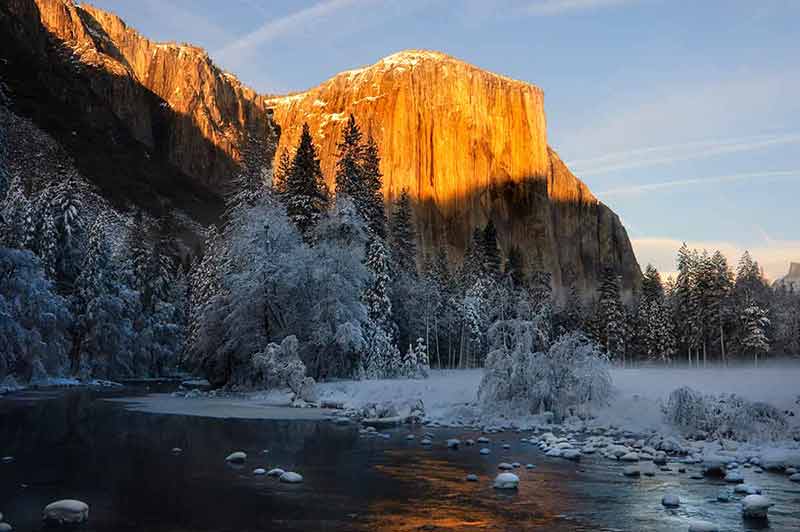
Yosemite National Park is one of the most popular places on earth for photography, with stunning landscapes, wildlife and changing seasons making for perfect photos.
During summer, you can see dozens of avid photographers setting up tripods or carrying cameras up the trails to get the perfect shot, but winter can provide equally amazing opportunities.
Aside from the unique Firefall, which draws photographers from far and wide, classic viewpoints such as Tunnel View, Glacier Point and even Yosemite Valley itself are transformed by snow in winter to a magical scene.
If you’re looking for a more guided trip, check out the photography tours that run every morning in winter by the Ansel Adams Gallery.
For these you’ll get a guide to take you to all the best spots and who can advise you on camera settings to ensure you get the best photos possible.
7- Watch The Firefall
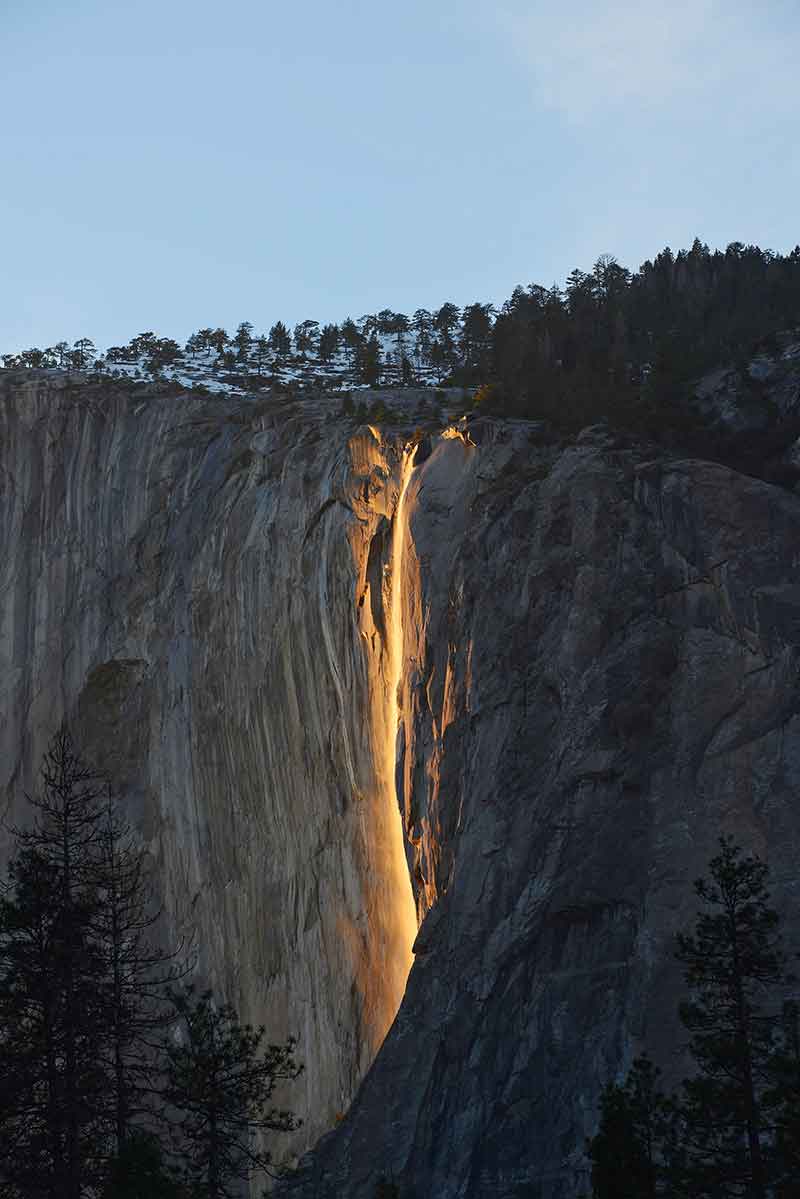
If you only plan your winter trip to Yosemite around one event, then it should be the incredible Yosemite Firefall.
Taking place during middle to end of February each year at Horsetail Falls, this event draws thousands from around the world – but don’t let that put you off.
As the falls melts and finally starts flowing again, the sunlight hits it at a certain angle at the right time each day for around two weeks.
The light creates the illusion of a powerful stream of flowing fire over the cliff edge, with epic valley views in the background.
The crowds are so intense that there is now a designated viewing area and to catch it at the right time requires a little extra research and planning, but it’s one of the most unique spectacles on earth.
Top Tips For Visiting Yosemite In Winter
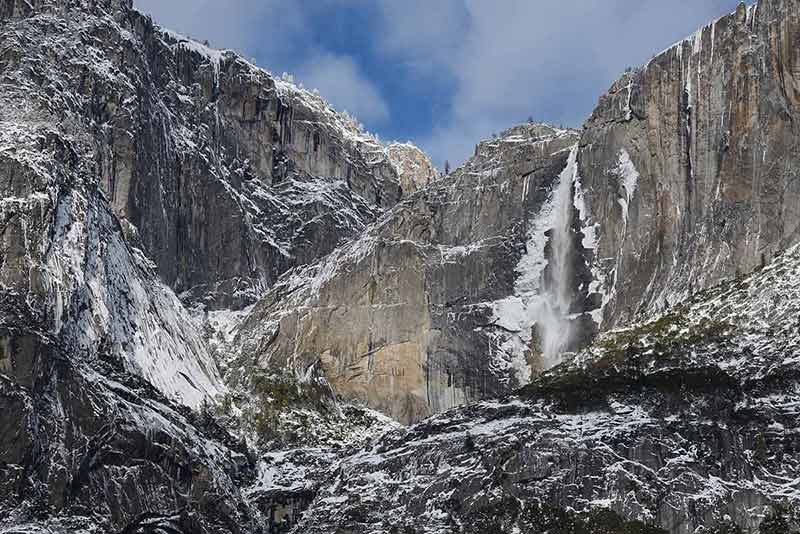
- Due to the weather, closures and changes in activities available, there are a few tips and things to remember if you plan to visit during the off-season.
- Bring winter gear – Aside from the previously mentioned snow chains and snow boots, don’t forget things like trekking poles, if you plan to hike, snow spikes or snowshoes.
- Trails can close, get icy or take longer than expected, so having GPS or a paper map is also useful, as is extra water, snacks and a flashlight.
- If you plan to ski, it may look white and snowy, but sunscreen is also essential out on the slopes.
When to visit
If you’ve never been to Yosemite before, or this is a bucket list trip, consider waiting until Spring or Summer.
Winter is extremely beautiful and there’s tonnes to do, but almost all of the eastern side of the park is closed including the Tioga Pass, which at 10,000ft elevation, is arguably one of the most spectacular regions .
However, if you’ve visited before or are particularly looking forward to the park’s winter sports opportunities, there isn’t a better time to go than when it’s quiet and covered in snow.
Beware of bears – Yes, they may be hibernating during winter but bears are a serious factor whenever you visit Yosemite.
You’ll notice that almost every car park, campsite and hotel has bear-proof bins, and many trailheads have steel lockers for you to put your stuff in.
Don’t leave anything with a scent in your car, even a wrapper, as bears have been known to smash windows.
If you plan to camp, avoid leaving any food or wrappers outside as tents offer far less protection!
Plan, plan, plan – It may seem like a winter wonderland, but Yosemite in winter requires far more planning than in summer.
Check the weather in advance in case of storms or heavy snow and ice, check the park website for road closures, accidents or trail closures and when you arrive stop at the Visitor’s Centre every day for up-to-date information.
Looking online in advance ensures you’re up to date on accommodation, trail and weather conditions and activity bookings, so you can maximise your visit.
Where To Stay In Yosemite In Winter
Rush Creek Lodge – For a unique, eco-friendly experience, Rush Creek Lodge is north of Yosemite Valley, just outside the park’s West entrance and is one of the more comfortable places to stay.
With a pool, restaurant and spa, plus a shop and in-depth knowledge of the park, it’s ideal for families, couples or solo adventurers.
The Ahwahnee – Yosemite’s most famous lodging, The Ahwahnee has beautiful old architecture and sits right in the heart of Yosemite Valley.
It has an excellent restaurant and bar, gift shop and outdoor swimming pool.
You won’t find staff who know more about things to do in the park, and this is where celebrities and presidents have stayed on visits to Yosemite.
Tenaya Lodge – Just beyond the park’s south entrance lies Tenaya Lodge, which is always in high demand each winter thanks to its spacious rooms with roaring fires, swimming pool, jacuzzis, four restaurants and a bar.
They are also experts in everything Yosemite, whether you want to go for a hike or organise a family ski trip.
Upper Pines Campground – Upper Pines is, as mentioned, one of the only campgrounds to remain open (and snow-free!) during winter.
It’s located near the Merced River in Yosemite Valley, on the park’s free shuttle route, and has space for tents, RVs and trailers.
Reservations in summer are almost impossible, but in winter it’s far quieter, and you’ll also have easy access to the restaurants and grocery stores in both Curry Village and Yosemite Village.
If you love exploring national parks, you might like to read:
- Wyoming National Parks Guide
- Nevada National Parks Guide
- Michigan National Parks Guide
- 5 Maine National Parks
- New Hampshire National Parks Guide
- 25 National Parks in Canada
- 17 National Parks in Argentina
- Tasmania National Parks
- 20 National Parks in Mexico
- 18 New Mexico National Parks
- 18 National Parks in Massachusetts
- 17 Colorado National Parks
- 4 Indiana National Parks
- 5 Nebraska National Parks
- 30 Virginia National Parks
- 9 New Jersey National Parks
- 8 National Parks in Arkansas
- 8 Alaska National Parks
- 13 Tennessee National Parks
- 6 National Parks in Louisiana
- 5 Illinois National Parks
- 7 National Parks in Oklahoma
- 7 National Parks in South Dakota
- 12 Alabama National Parks
- 5 North Dakota National Parks
- 8 National Parks in West Virginia
- 20 National Parks in Arizona
- 11 National Parks In Florida
- 8 Hawaii National Parks
- 6 National Parks In Idaho
- Texas National Parks Guide
- 9 California National Parks
- 11 National Parks In Georgia
- 7 National Parks In Missouri
- 5 National Parks in Minnesota
- 7 National Parks In Kentucky
- 8 National Parks In Montana
- 15 National Parks In Washington State
- 8 South Carolina National Parks
- 12 North Carolina National Parks
- 4 Wisconsin National Parks
- 20 National Parks In India
- 11 Oregon National Parks
- 5 Connecticut National Parks
- 27 National Parks In New York State
- 4 Iowa National Parks
- Yosemite National Park
- Zion National Park
- 21 National Parks in Pennsylvania
- 9 National Parks in Mississippi
- 5 National Parks in Rhode Island
- 9 National Parks in Taiwan
- 20 East Coast National Parks
- Guide To Winter in Yellowstone National Park
Plan Your Trip

Rent A Car – Find the best car rental rates at Discover Cars. They compare car hire companies to provide you with the best deal right now.

Find A Hotel – If you’re curious about this article and are looking for somewhere to stay, take a look at these amazing hotels.





